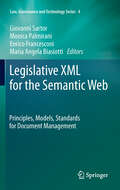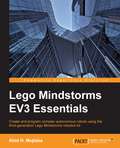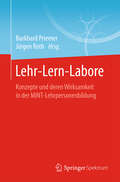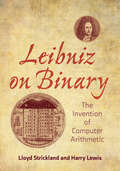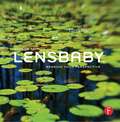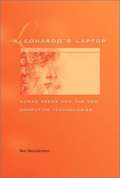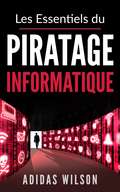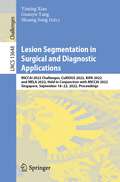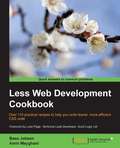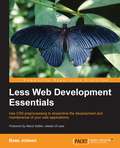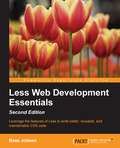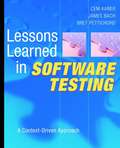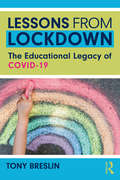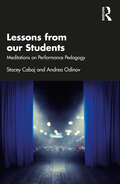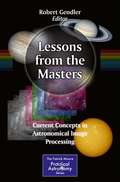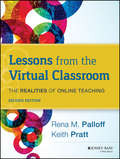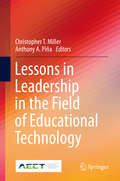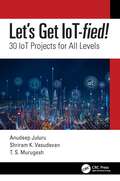- Table View
- List View
LegalTech and Legal-AI in Business: Major and Promising Sectors of Economy (Intelligent Systems Reference Library #276)
by Agnessa Inshakova Denis Matytsin Iolanta BaltutiteThis book offers an interdisciplinary scientific study and ecosystem description of organizational and institutional mechanisms for the introduction of artificial intelligence technologies, digital technologies and robotic systems in the legal support of business processes, the development of regulatory mechanisms to protect the rights of business entities in the digital economy, and the formation of the sixth technological mode. This book includes the study of legal support of the main and promising areas of business, in the regulation of which robotics, digital technologies, and artificial intelligence are actively used to increase efficiency, protect the rights of participants, minimize business risks, improve quality, and stimulate innovation in companies and high-tech production. This book provides applied recommendations for preventing and managing business risks in the context of the application of artificial intelligence and robotics in law.
Legislative XML for the Semantic Web
by Giovanni Sartor Maria Angela Biasiotti Monica Palmirani Enrico FrancesconiThis volume examines the basic layers of the standard-based creation and usage of legislation. In particular, it addresses the identification of legislative documents, their structure, the basic metadata and legislative changes. Since mature technologies and established practices are already in place for these layers, a standard-based approach is a necessary aspect of the up-to-date management of legislative resources. Starting out with an overview of the context for the use of XML standards in legislation, the book next examines the rationale of standard-based management of legislative documents. It goes on to address such issues as naming, the Akoma-Ntoso document model, the contribution of standard-based document management to handling legislative dynamics, meta-standards and interchange standards. The volume concludes with a discussion of semantic resources and a review on systems and projects.
Lego Mindstorms EV3 Essentials
by Abid H. MujtabaIf you are a robot enthusiast who wants to quickly get the most out of Lego Mindstorms EV3, this is the book for you. Prior programming experience is useful to get the most out of this book, but not necessary.
Lehr-Lern-Labore: Konzepte und deren Wirksamkeit in der MINT-Lehrpersonenbildung
by Jürgen Roth Burkhard PriemerAn verschiedenen Hochschulen werden in den MINT-Fächern Schülerlabore in die Lehrpersonenbildung integriert. In diesen - als Lehr-Lern-Labore bezeichneten - Einrichtungen werden MINT-Lernumgebungen für Schülerinnen und Schüler, Veranstaltungen der Lehrpersonenbildung und an vielen Standorten auch fachdidaktische Forschung fruchtbar miteinander verknüpft. Das Ziel ist dabei, evidenzbasiert innovative Lehrkonzepte für Schule und Hochschule zu entwickeln und zu implementieren. In diesem Band werden Lehr-Lern-Labore zunächst allgemein beschrieben und dann durch zahlreiche Beispiele von Konzepten verschiedener Hochschulstandorte illustriert. Darüber hinaus wird berichtet, welche Wirksamkeit Lehr-Lern-Labore bei der Förderung von Kompetenzen zukünftiger Lehrpersonen haben und wie Studierende diese Einrichtungen wahrnehmen. Die vorgestellten Forschungsergebnisse, die aus einem Verbund von sechs Hochschulen stammen, sollen durch diesen Band weiteren Standorten zugänglich gemacht werden. Dieses Buch richtet sich an Studierende und Dozierende der Lehrpersonenbildung in Hochschulen - insbesondere in den MINT-Fachdidaktiken - sowie an Personen in Schule und Referendariat.
Lehrbuch Grundlagen der BIM-Arbeitsmethode: Fragen, Übungen, Fallbeispiele (erfolgreich studieren)
by Henriette Strotmann Habeb AstourEin allgemeingültiges BIM-Lehrbuch zu den Grundlagen der Arbeitsmethode BIM für Studierende und Lehrende an den deutschsprachigen Hochschulen. Jedes Kapitel schließt mit reflektierenden und zusammenfassenden Fragen und Übungen zu den vermittelten BIM-Kentnissen und -Fertigkeiten ab. Unabhängig von Institutionen und Software wird das Basiswissen neutral vermittelt. Videos zur Implementierung von BIM im Unternehmen runden das Lehbuch ab. Die Publikation erscheint in der Springer Vieweg Lehrbuchreihe erfolgreich studieren.
Lehrbuch für digitales Fertigungsmanagement: Manufacturing Execution Systems - MES
by Jürgen Kletti Rainer DeisenrothDie Anforderungen an IT-Systeme im Produktionsumfeld sind permanent gewachsen und die Digitalisierung der Fertigungsprozesse ist ohne den Einsatz von Manufacturing Execution Systemen (MES) nicht mehr vorstellbar. MES dienen mittlerweile dazu, alle an der Fertigung direkt oder indirekt beteiligten Systeme, Elemente und Ressourcen im Sinne einer zentralen Datendrehscheibe sowohl horizontal als auch vertikal zu vernetzen. Sie sind damit eine wichtige Plattform für eine lückenlose Digitalisierung und den Aufbau einer Smart Factory.Wendet man die aufgabenorientierte Sichtweise nach der VDI-Richtlinie 5600 an, werden Manufacturing Execution Systemen wichtige Aufgaben aus den produktionsnahen Bereichen Auftragsmanagement, Feinplanung und Feinsteuerung, Betriebsmittelmanagement, Datenerfassung, Materialmanagement, Personalmanagement, Energiemanagement, Informationsmanagement, Qualitätsmanagement und Leistungsanalyse übertragen. MES helfen mit ihren Echtzeitbetrachtungen, vergangenheitsbezogenen Analysen sowie den Feinplanungsfunktionen dabei, die täglichen Herausforderungen im Sinne einer effektiven Steuerung und permanenten Verbesserung der Produktionsprozesse zu bewältigen.Dieses Lehrbuch erläutert im Wesentlichen die Funktionen und den Einsatz der Manufacturing Execution Systeme.Die Zielgruppen• Studierende der Fachrichtungen Wirtschaftsingenieurwesen, Betriebswirtschaftslehre und Wirtschaftsinformatik• Praktiker in produzierenden Unternehmen in fertigungsnahen Bereichen, im Controlling und im Management
Leibniz on Binary: The Invention of Computer Arithmetic
by Lloyd Strickland Harry R. LewisThe first collection of Leibniz&’s key writings on the binary system, newly translated, with many previously unpublished in any language.The polymath Gottfried Wilhelm Leibniz (1646–1716) is known for his independent invention of the calculus in 1675. Another major—although less studied—mathematical contribution by Leibniz is his invention of binary arithmetic, the representational basis for today&’s digital computing. This book offers the first collection of Leibniz&’s most important writings on the binary system, all newly translated by the authors with many previously unpublished in any language. Taken together, these thirty-two texts tell the story of binary as Leibniz conceived it, from his first youthful writings on the subject to the mature development and publication of the binary system. As befits a scholarly edition, Strickland and Lewis have not only returned to Leibniz&’s original manuscripts in preparing their translations, but also provided full critical apparatus. In addition to extensive annotations, each text is accompanied by a detailed introductory &“headnote&” that explains the context and content. Additional mathematical commentaries offer readers deep dives into Leibniz&’s mathematical thinking. The texts are prefaced by a lengthy and detailed introductory essay, in which Strickland and Lewis trace Leibniz&’s development of binary, place it in its historical context, and chart its posthumous influence, most notably on shaping our own computer age.
Lens on Life: Documenting Your World Through Photography
by Stephanie C. RobertsMostly candid and spontaneous, documentary photography serves to preserve a moment in time. In Lens on Life, celebrated documentary photographer Stephanie Calabrese Roberts inspires you to explore, shoot, and share documentary photographs, guiding you as you define your own style. Illustrated with the author's striking artwork as well as that of eight seasoned photographers who have visually documented stories all over the world, this book will sharpen your artistic intuition and give you the confidence to take on personal or professional documentary assignments. Full of advice that will challenge you and strengthen your photography, Lens on Life shows you how to capture an authentic view of your world.
Lensbaby: Bending your perspective
by Corey HilzIf you've ever wished you could learn about all of the creative possibilities the Lensbaby offers, this is the book for you! Seeing subjects with a new perspective is at the heart of the Lensbaby experience, and with the essential information found in this book, you'll be able to take your creative exploration to the next level. Written by Lensbaby Guru Corey Hilz, Lensbaby: Bending Your Perspective starts off with an overview of each lens in the Lensbaby suite. Then comes the fun stuff! Packed with tips on composition and techniques for capturing your best images, you'll be immersed in the wonderful world of Lensbaby in no time. On nearly every page you'll find a full color image created by a Lensbaby expert to inspire your own shooting. You'll also find complete coverage of all of the Lensbaby accessories, from the Optic Swap System to a macro kit, creative aperture discs, and a super wide angle lens. With this gorgeous and practical book by your side, you'll never see the world in the same way again.
Leonardo's Laptop: Human Needs and the New Computing Technologies
by Ben Shneiderman2003 IEEE-USAB Award for Distinguished Literary Contributions Furthering Public Understanding of the Profession. and Selected as a Finalist in the category of Computer/Internet in the 2002 Independent Publisher Book Awards (IPPYs) presented by Independent Publisher Magazine Ben Shneiderman's book dramatically raises computer users' expectations of what they should get from technology. He opens their eyes to new possibilities and invites them to think freshly about future technology. He challenges developers to build products that better support human needs and that are usable at any bandwidth. Shneiderman proposes Leonardo da Vinci as an inspirational muse for the "new computing." He wonders how Leonardo would use a laptop and what applications he would create. Shneiderman shifts the focus from what computers can do to what users can do. A key transformation is to what he calls "universal usability," enabling participation by young and old, novice and expert, able and disabled. This transformation would empower those yearning for literacy or coping with their limitations. Shneiderman proposes new computing applications in education, medicine, business, and government. He envisions a World Wide Med that delivers secure patient histories in local languages at any emergency room and thriving million-person communities for e-commerce and e-government. Raising larger questions about human relationships and society, he explores the computer's potential to support creativity, consensus-seeking, and conflict resolution. Each chapter ends with a Skeptic's Corner that challenges assumptions about trust, privacy, and digital divides.
Les Essentiels du Piratage Informatique
by Adidas WilsonLe Guide du débutant à la piraterie informatique éthique et le test de pénétration. À l'origine, le terme "hacker" désignait un programmeur qui maîtrisait les systèmes d'exploitation informatiques et le code machine. Aujourd'hui, il s'agit de toute personne qui pratique des activités de piratage informatique. Le piratage est l'acte de changer les caractéristiques d'un système pour atteindre un but qui l'est. À l'origine, le terme "hacker" désignait un programmeur qui maîtrisait les systèmes d'exploitation informatiques et le code machine. Aujourd'hui, il s'agit de toute personne qui pratique des activités de piratage informatique. Le piratage est l'acte de modifier les caractéristiques d'un système pour atteindre un but qui n'est pas dans le but original du créateur. Le mot "piratage" est généralement perçu négativement, surtout par les personnes qui ne comprennent pas le travail d'un pirate éthique. Dans le monde du hacking, les hackers éthiques sont des gentils. Quel est leur rôle ? Ils utilisent leur vaste connaissance des ordinateurs pour de bonnes raisons plutôt que pour des raisons malveillantes. Ils recherchent les vulnérabilités dans la sécurité informatique des organisations et des entreprises pour empêcher les mauvais acteurs d'en profiter. Pour quelqu'un qui aime le monde de la technologie et des ordinateurs, il serait sage d'envisager une carrière de piratage éthique. Vous êtes payé (un bon montant) pour pénétrer dans les systèmes. Le début ne sera pas une promenade dans le parc, comme pour toute autre carrière. Cependant, si vous êtes déterminé, vous pouvez vous lancer dans une carrière lucrative. Lorsque vous déciderez de commencer ce voyage, vous devrez cultiver la patience. La première étape pour beaucoup de gens est habituellement d'obtenir un diplôme en informatique. Vous pouvez également obtenir une certification A+ (CompTIA) - vous devez passer et réussir deux examens différents. Pour p
Les tableaux croisés dynamiques avec Excel
by A. J. WrightCe livre s’adresse à tout utilisateur d’Excel. On s’accorde à dire que soixante pour cent des utilisateurs d’Excel n’utilisent que vingt pour cent de ses capacités. Autrement dit, la plupart sont très loin de se servir de tous les outils intégrés. Parmi ces derniers, les plus féconds, et de loin, sont les tableaux et les graphiques croisés dynamiques. Bien que ces deux outils aient été la pierre angulaire d’Excel depuis plus de seize ans, ils restent les plus sous-utilisés de toute la suite MicroSoft Office. Puisque vous avez découvert ce livre, vous êtes assez informé pour en avoir déjà entendu parler, ou même les avoir utilisés à l’occasion. Vous avez compris qu’ils recèlent une puissance dont vous ne vous servez pas et voulez apprendre comment tirer parti de cette dernière pour améliorer rapidement votre productivité. À l’aide de ce simple livre, vous serez capable de générer des tableaux et graphiques croisés simples, d’augmenter votre rendement et de créer ces deux choses en quelques minutes au lieu de plusieurs heures. Dès le troisième chapitre, vous pourrez réaliser des tableaux croisés complexes munis d’analyses en profondeur avec leurs graphiques associés. Arrivé à la fin du livre, vous pourrez concevoir un système dynamique de génération de tableaux et graphiques croisés.
Lesion Segmentation in Surgical and Diagnostic Applications: MICCAI 2022 Challenges, CuRIOUS 2022, KiPA 2022 and MELA 2022, Held in Conjunction with MICCAI 2022, Singapore, September 18–22, 2022, Proceedings (Lecture Notes in Computer Science #13648)
by Yiming Xiao Guanyu Yang Shuang SongThis book constitutes three challenges that were held in conjunction with the 25th International Conference on Medical Image Computing and Computer-Assisted Intervention, MICCAI 2022, which took place in Singapore in September 2022. The peer-reviewed 10 papers included in this volume stem from the following three challenges: Kidney Parsing Challenge 2022: Multi-Structure Segmentation for Renal Cancer Treatment (KiPA 2022) The 2022 Correction of Brain Shift with Intra-Operative Ultrasound-Segmentation Challenge (CuRIOUS-SEG 2022) The 2022 Mediastinal Lesion Analysis Challenge (MELA 2022)
Less Web Development Cookbook
by Bass Jobsen Amin MeyghaniAimed at those who want to overcome the limitations of CSS, through this book you will begin to harness the efficiency of Less by building advanced, responsive, and modern websites. Experienced web developers, students, and even web designers will find this guide very useful as they enhance their CSS skills.
Less Web Development Essentials
by Bass JobsenWritten in a practical and concise manner, this book is a crash-course in teaching you the fundamental concepts of Less with real-life examples and problems. If you use CSS(3) in your web development tasks and would love to learn how to create maintainable and reusable code with Less, this book is ideal for you. Although you need to have some experience in web development, even beginners will find that this book is useful.
Less Web Development Essentials - Second Edition
by Bass JobsenIf you use CSS for web development tasks and want to learn how to create maintainable and reusable code, this is the book for you. Basic knowledge of web development would be helpful.
Lessons Learned in Software Testing
by Cem Kaner James Bach Bret PettichordDecades of software testing experience condensed into the most important lessons learned. The world's leading software testing experts lend you their wisdom and years of experience to help you avoid the most common mistakes in testing software. Each lesson is an assertion related to software testing, followed by an explanation or example that shows you the how, when, and why of the testing lesson. More than just tips, tricks, and pitfalls to avoid, Lessons Learned in Software Testing speeds you through the critical testing phase of the software development project without the extensive trial and error it normally takes to do so. The ultimate resource for software testers and developers at every level of expertise, this guidebook features: * Over 200 lessons gleaned from over 30 years of combined testing experience * Tips, tricks, and common pitfalls to avoid by simply reading the book rather than finding out the hard way * Lessons for all key topic areas, including test design, test management, testing strategies, and bug reporting * Explanations and examples of each testing trouble spot help illustrate each lesson's assertion
Lessons from Lockdown: The Educational Legacy of COVID-19
by Tony BreslinLessons from Lockdown explores the impact of COVID-19 on our schooling systems, on the young people and families that they serve and on all who work in – and with – our schools, and asks what the long-term ramifications of the pandemic might be for the pedagogy and purpose of formal education. Drawing on the voices of more than a hundred pupils, parents and professionals, it reveals how teachers and learners are adapting practice in areas such as curriculum modelling, parental engagement, assessment and evaluation and blended and online learning. In this timely new book, Tony Breslin draws on his experience as a teacher, researcher, examiner, school governor and policy influencer to assess what the educational legacy of COVID-19 could be, and the potential that it offers for reframing how we ‘do’ schooling. Whatever your place in this landscape, Lessons from Lockdown is a must-read for all concerned about the shape and purpose of schooling systems in mature economies – schooling systems and economies set on recovering from the kind of ‘system shock’ that the pandemic has delivered.
Lessons from our Students: Meditations on Performance Pedagogy
by Stacey Cabaj Andrea OdinovLessons from our Students: Meditations on Performance Pedagogy is a collection of thirty short personal case studies about pedagogical issues that arise in theater classrooms and rehearsals. Teaching in the acting and performance classroom is rapidly changing in the early 2020s. In the wake of the global pandemic, online education, massive trauma, and a social justice revolution, educators are seeking wisdom, clarity, and reassurance about their pedagogy. The authors speak to the current moment and the unique challenges of teaching theater by presenting a personal, practical, and authentic expression of vulnerability, humanity, and artistry as teachers. Through thirty personal meditations, the authors pose reflective questions and discussion prompts that evaluate the craft of teaching theater, issues that arise, and ideas about how to respond with vision and integrity. Accompanying exercises invite readers to reflect on their own teaching practices. This book serves as a text for theater teachers and teachers-in-training in search of inspiration, validation, and transformation in drama education and theater pedagogy classes.
Lessons from the Masters: Current Concepts in Astronomical Image Processing
by Robert GendlerThere are currently thousands of amateur astronomers around the world engaged in astrophotography at a sophisticated level. Their ranks far outnumber professional astronomers doing the same and their contributions both technically and artistically are the dominant drivers of progress in the field today. This book is a unique collaboration of individuals world-renowned in their particular area and covers in detail each of the major sub-disciplines of astrophotography. This approach offers the reader the greatest opportunity to learn the most current information and the latest techniques directly from the foremost innovators in the field today. "Lessons from the Masters" includes a brilliant body of recognized leaders in astronomical imaging, assembled by Robert Gendler, who delivers the most current, sophisticated and useful information on digital enhancement techniques in astrophotography available today. Each chapter focuses on a particular technique, but the book as a whole covers all types of astronomical image processing, including processing of events such as eclipses, using DSLRs, and deep-sky, planetary, widefield, and high resolution astronomical image processing. Recognized contributors include deep-sky experts such as Jay GaBany, Tony Hallas, and Ken Crawford, high-resolution planetary expert Damian Peach, and the founder of TWAN (The World at Night) Babak A. Tafreshi. A large number of illustrations (150, 75 in color) present the challenges and accomplishments involved in the processing of astronomical images by enthusiasts.
Lessons from the Transition to Pandemic Education in the US: Analyses of Parent, Student, and Educator Experiences (Routledge Research in Education)
by Marni E. Fisher; Kimiya Sohrab Maghzi; Charlotte Achieng-Evensen; Meredith A. Dorner; Holly Pearson; Mina ChunThis volume narrates and shares the often-unheard voices of students, parents, and educators during the COVID-19 pandemic. Through close analysis of their lived experiences, the book identifies key patterns, pitfalls, and lessons learnt from pandemic education. Drawing on contributions from all levels of the US education system, the book situates these myriad voices and perspectives within a prismatic theory framework in order to recognise how these views and experiences interconnect. Detailed narrative and phenomenological analysis also call attention to patterns of inequality, reduced social and emotional well-being, pressures on parents, and the role of communication, flexibility, and teacher-led innovation. Chapters are interchanged with interludes that showcase a lyrical and authentic approach to understanding the multiplicity of experience in the text. Providing a valuable contribution to the contemporary field of pandemic education research, this volume will be of interest to researchers, academics, and educators with an interest in the sociology of education, online teaching and eLearning, and those involved with the digitalization of education at all levels. Those more broadly interested in educational research methods and the effects of home-schooling will also benefit.
Lessons from the Virtual Classroom
by Keith Pratt Rena M. PalloffRena Palloff and Keith Pratt, the most trusted online teaching experts, have completely updated and revised this classic to reflect changes in technology and advances in online teaching made in the last decade, in order to meet today's online learning challenges. The book continues to offer helpful suggestions for dealing with such critical issues as evaluating effective tools, working with online classroom dynamics, addressing the special needs of online students, making the transition to online teaching, and promoting the development of the learning community. Filled with numerous examples from actual online courses and insights from teachers and students, new topics include the open source movement, Web 2.0, Google groups, and topics for the K-12 sector.
Lessons in Leadership in the Field of Educational Technology
by Anthony A. Piña Christopher T. MillerThe idea for this edited book came about due to the increased discussion and focus on leadership within the educational technology field and particularly in the Association for Educational Communications and Technology organization. There is a diverse amount of individuals in leadership in the field that contributed their lessons learned. This book focuses on sharing the lessons learned by leaders in the field on how they became a leader and what leadership means. The primary contributions address three central questions. What is your story about how you became a leader? What lessons have you learned about being an effective leader? What advice would you give others to become a leader? In addition, this book spotlights the impact that past leaders have had on current leaders and upon the field of educational technology.
Let It Go: My Extraordinary Story - From Refugee to Entrepreneur to Philanthropist
by Richard Askwith Dame Stephanie Shirley CHA moving memoir from a woman who made a fortune in a man's world and then gave it all away...soon to be turned into a filmIn 1962, Stephanie 'Steve' Shirley created a software company when the concept of software barely existed. Freelance Programmers employed women to work on complex projects such as Concorde's black box recorder from the comfort of their own home. Shirley empowered a generation of women in technology, giving them unheard of freedom to choose their own hours and manage their own workloads. The business thrived and Shirley gradually transferred ownership to her staff, creating 70 millionaires in the process.Let It Go explores Shirley's trail blazing career as an entrepreneur but it also charts her incredible personal story - her dramatic arrival in England as an unaccompanied Kindertransport refugee during World War Two and the tragic loss of her only child who suffered severely from Autism.Today, Dame Stephanie Shirley is one of Britain's leading philanthropists, devoting most of her time, energy and wealth to charities that are close to her heart. In Let It Go, Shirley tells her inspirational story and explains why giving her wealth away - letting it go - has brought her infinitely more happiness and fulfilment than acquiring it in the first place.Co-written with Richard Askwith, the former Executive Editor of The Independent and the award-winning author of seven books in his own name, including biographies of Emil Zátopek and Lata Brandisová.'An extraordinary tale of creativity and resilience' - Guardian'This engrossing story of an extraordinary life is filled with lessons in what it means to be human' - Financial Times
Let's Get IoT-fied!: 30 IoT Projects for All Levels
by Shriram K. Vasudevan Anudeep Juluru T.S. MurugeshInternet of Things (IoT) stands acclaimed as a widespread area of research and has definitely enticed the interests of almost the entire globe. IoT appears to be the present as well as the future technology. This book attempts to inspire readers to explore and become accustomed to IoT. Presented in a lucid and eloquent way, this book adopts a clear and crisp approach to impart the basics as expeditiously as possible. It kicks off with the very fundamentals and then seamlessly advances in such a way that the step-by-step unique approach, connection layout, and the verified codes provided for every project can enhance the intuitive learning process and will get you onboard to the world of product building. We can assure that you will be definitely raring to start developing your own IoT solutions and to get yourself completely lost in the charm of IoT. Let’s start connecting the unconnected! It’s time to get IoT-fied.

